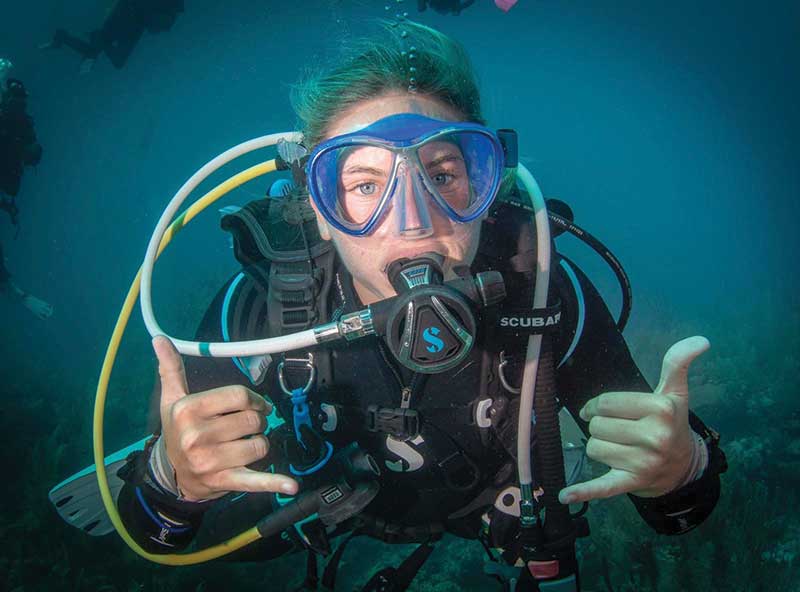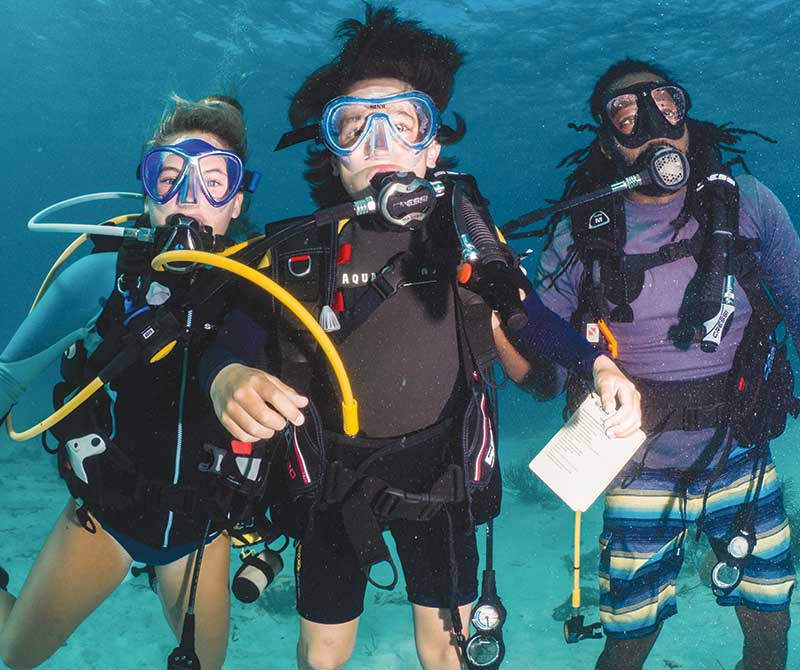Pee Breaks and Fluffy Rabbits
By Margo Peyton & Holly Wakely

Holly Wakely is Kids Sea Camp’s youngest Open Water Instructor. Photos courtesy: Kids Sea Camp
Holly Wakely has been diving with Kids Sea Camp (KSC) since she was four years old. She is now 18. This year Holly decided to take a university gap year and intern with us at KSC. She was our first-ever Junior Dive Master and has just become an Open Water Scuba Instructor. Holly wanted to gain some experience teaching, so I asked her to join us in Belize this spring break to help her gain some kid-friendly experience. She came up with 10 things she learned. Her observations are useful, fun, and worth sharing…
10 things I learned
In February 2021, I became a PADI Dive Instructor with Kids Sea Camp at Buddy Dive in Bonaire. This has been a dream of mine since I became a Jr. Rescue Diver six years ago. Thanks to Margo’s dive leader internship programs, I was able to gain experience this spring break in Belize as a freshly-minted PADI Instructor. Margo paired me each week with very experienced and seasoned KSC instructors so that I could learn and gain confidence. The first week I assisted as part of the team with four students: Izabella age 10, and Natalia, an adult mom with her two sons, Daniel age 14 and Alex age 11. The second week I was the lead instructor with an assistant for two kids, 10-year-old Marcello and 13-year-old Brooklyn. The third and final week, I worked with 10-year-old Logan and his mom, Bailey. Here is my journey across these three weeks of teaching in Belize. It was a rollercoaster!
My PADI Course director Lars at Buddy Dive prepared me well. He made sure, knowing I was becoming a Kids Sea Camp instructor, to drill me on the best and most effective ways to teach both adults and kids. But real-life teaching poses some obstacles that you don’t learn in your IDC! From teaching excited, tired, hungry, chatty kids, to bouncy boat rides, or scary skills—boy, did I learn a lot more than I anticipated, such as how to plan a pee schedule!
Each one of the weeks I had a 10-year-old Junior Open Water diver to teach. Some people argue that ten is too young to dive. I know it’s not, because I was certified at ten and I know it is entirely possible for a young diver to join the underwater world with the right kid-friendly instructor. Luckily for me, each of my students had participated in either SASY or SEAL team over their years with KSC, so already they were comfortable with a regulator in their mouth and swimming and snorkelling in open water. Each student came with their own unique set of fears and stresses. So here are 10 slightly random things I learned to overcome real-life Jr. Open Water obstacles and encourage each of my students to complete their training and become certified.
Sunscreen is useful for more than just sun protection. It’s jellyfish sting-proof, and for pre-existing cuts, scrapes, or bug bites that can sting in saltwater, lather them in sensitive-skin waterproof sunscreen (bonus points if it’s reef-safe) and let the kids know that—like magic—no stings in saltwater anymore!
Sometimes you have to negotiate class time and training. Kids want to play but you have confined water sessions to do? Make it a fun and creative playtime after classes are completed for the day. Some water volleyball or paddle boarding, crab races, or even a smoothie is a great reward.
Food is fuel! This one I kind of taught myself, I think I got hungrier than the kids did going out daily in the hot sun! Frequent snack and water breaks are important for keeping energy up. Plus it helps taking breaks so the course is not too daunting for little ones.

Everything is bigger for kids because they’re small. 40 feet (12m) may only be 7 times your height, but it can be 10 times their height. This can make the ocean seem really intimidating. It helps a lot if they can see the bottom and have clear calm water to begin in. Stay shallow, I find 20ft (6m) the perfect depth for the first ten dives.
The scariest skill is the full mask removal and replacement. Saltwater burns their little eyes and scares them. Practice this repeatedly in freshwater during the confined sessions. Let them know they can keep their eyes closed and you can hold on to them. Let them practice in saltwater without dive gear while snorkelling and then complete in class on open water dive.
Kids learn from watching you. They copy what you do and how you do it, so make sure you are your best diver self when diving with them.
Keep things fun. Acronyms are boring until they’re not. Take BWRAF, the buddy check. You may know it as Begin With Review And Friend—at least this is how it’s taught in the book. At 10 I would never remember this. Make it Big White Rabbits Are Fluffy or Burger With Relish And Fries and suddenly its glued into not only my short-term memory but my long-term memory, too.
As soon as their internal timer hits 25 minutes, they’re freezing. Layering wetsuits or skins helps, but kids are naturally going to get colder more quickly than adults. Unless you show them something crazy cool (this could be just a turtle to us, but they’ve never seen a real live sea turtle before) then suddenly they’re distracted from the slight cold and are excited about diving.
Mask flap straps are the most useful piece of equipment they could own. No joke! For some reason, kids’ hair gets every where and the rubber strap is sticky and hurts. Flap straps make it easy to put masks on and off. They look cool, too.
Pee schedules. OMG little kids have to go to the bathroom all the time! They have little bladders and they are drinking lots of water to stay hydrated. So be prepared to take lots of bathroom breaks. A two-piece wetsuit comes in much more handy than a one-piece. And NO they will not pee in their suit or the pool, so make sure the toilet is close by.
Margo Peyton is the founder of Kids Sea Camp and Family Dive Adventures, with over 6,000 certified kids and zero dive accidents! For more info: www.familydivers.com
Leave a Comment







